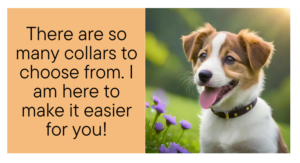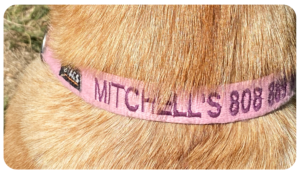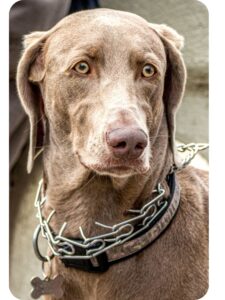 If you’re like me, then you only want the best for your dog. So, how do we know which collar is best? It’s more than just a fashion choice; it’s about comfort, safety, and nurturing a positive relationship with our pups.
If you’re like me, then you only want the best for your dog. So, how do we know which collar is best? It’s more than just a fashion choice; it’s about comfort, safety, and nurturing a positive relationship with our pups.
In this guide, we’ll explore the various types of dog collars and how they can impact your dog’s daily life.
The Essential Flat Collar
Think of a flat dog collar as the trusty sedan of the dog collar world. Simple, classic, and essential. It rests comfortably around your pup’s neck, ready for a quick leash attachment as you head out the door. This type of collar, often made of nylon or leather, keeps identification and vaccination tags in one handy place.
Which Flat Collar?
 I love this collar for my dog. I have our family name and my phone number embroidered on the collar. This brand creates comfortable, high-quality collars that can last a lifetime.
I love this collar for my dog. I have our family name and my phone number embroidered on the collar. This brand creates comfortable, high-quality collars that can last a lifetime.
I recommend embroidering your dog’s collar instead of using a dog tag. Why? Because you know the ID tag cannot break off. If you get separated from your dog, someone could easily contact you.
I also think it’s better to include my family name on the collar instead of my dog’s name. I’ve heard stories of people keeping a lost dog who didn’t respond to their name. These people might be more likely to return a lost dog if they don’t know the pup’s name.
Many people keep their dog’s flat collar on at all times. You only want to attach a leash to your dog’s flat collar for short trips, like a potty break in your yard. For lengthier leash outings, reach for a harness instead.
Avoid The Alternatives
Now, let’s look at the collars that create a bit more controversy – the choke, pinch, prong, and shock collars. Please don’t use these collars. There is always a better way. You can train your dog with kindness.
The Risks
 Collars that constrict, pinch, or shock are inhumane. Choke and prong collars, for instance, can lead to serious injury. Shock collars can cause debilitating fear responses and aggression in dogs. The potential harm is not worth the risk.
Collars that constrict, pinch, or shock are inhumane. Choke and prong collars, for instance, can lead to serious injury. Shock collars can cause debilitating fear responses and aggression in dogs. The potential harm is not worth the risk.
A dog should never feel pain or fear in response to a training method. It’s important to remember that dogs are sensitive beings.
I can confidently say that in my 30 years of experience, dogs respond best to positive reinforcement and reward-based training. This type of training promotes trust, strengthens the bond between you and your dog, and creates a happy, well-behaved pet.
Your Methodology Matters
How you decide to train your pup shapes the bond you share. Positive training methods focus on reinforcing good behaviors rather than punishing unwanted ones. Your dog’s collar supports your overarching training strategy.
Final Thoughts
The next time you reach for your dog’s collar, envision it as more than an accessory. Recognize it as a commitment to the well-being of your pup. Using a collar responsibly and with positive training techniques can create a beautiful relationship between you and your dog.
So, the next time you’re out for a walk, remember to choose the right collar, and always lead with kindness. By doing so, you’ll be setting the foundation for a happy, healthy life for your dog. Happy training!
Tom Mitchell
The 1 Minute Dog Trainer
Disclaimer: As an affiliate on Amazon and other sites, I earn commission from qualifying purchases from the links above. This in no way adds an additional charge to your purchase.






